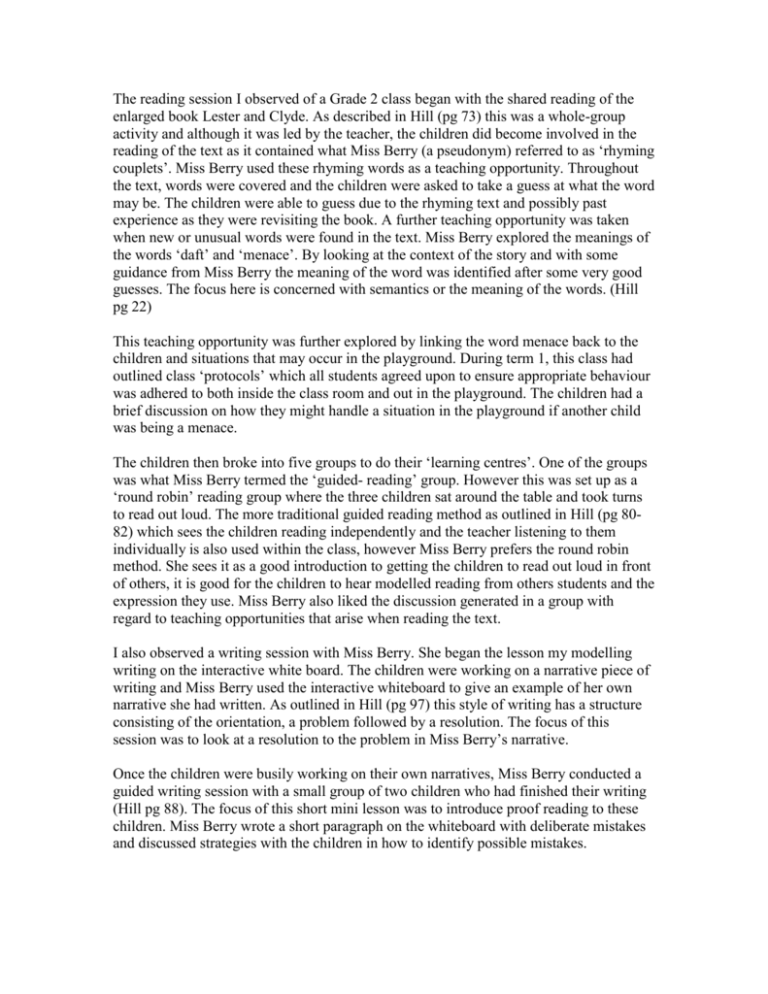The reading session I observed of a Grade 2 class began with the
advertisement

The reading session I observed of a Grade 2 class began with the shared reading of the enlarged book Lester and Clyde. As described in Hill (pg 73) this was a whole-group activity and although it was led by the teacher, the children did become involved in the reading of the text as it contained what Miss Berry (a pseudonym) referred to as ‘rhyming couplets’. Miss Berry used these rhyming words as a teaching opportunity. Throughout the text, words were covered and the children were asked to take a guess at what the word may be. The children were able to guess due to the rhyming text and possibly past experience as they were revisiting the book. A further teaching opportunity was taken when new or unusual words were found in the text. Miss Berry explored the meanings of the words ‘daft’ and ‘menace’. By looking at the context of the story and with some guidance from Miss Berry the meaning of the word was identified after some very good guesses. The focus here is concerned with semantics or the meaning of the words. (Hill pg 22) This teaching opportunity was further explored by linking the word menace back to the children and situations that may occur in the playground. During term 1, this class had outlined class ‘protocols’ which all students agreed upon to ensure appropriate behaviour was adhered to both inside the class room and out in the playground. The children had a brief discussion on how they might handle a situation in the playground if another child was being a menace. The children then broke into five groups to do their ‘learning centres’. One of the groups was what Miss Berry termed the ‘guided- reading’ group. However this was set up as a ‘round robin’ reading group where the three children sat around the table and took turns to read out loud. The more traditional guided reading method as outlined in Hill (pg 8082) which sees the children reading independently and the teacher listening to them individually is also used within the class, however Miss Berry prefers the round robin method. She sees it as a good introduction to getting the children to read out loud in front of others, it is good for the children to hear modelled reading from others students and the expression they use. Miss Berry also liked the discussion generated in a group with regard to teaching opportunities that arise when reading the text. I also observed a writing session with Miss Berry. She began the lesson my modelling writing on the interactive white board. The children were working on a narrative piece of writing and Miss Berry used the interactive whiteboard to give an example of her own narrative she had written. As outlined in Hill (pg 97) this style of writing has a structure consisting of the orientation, a problem followed by a resolution. The focus of this session was to look at a resolution to the problem in Miss Berry’s narrative. Once the children were busily working on their own narratives, Miss Berry conducted a guided writing session with a small group of two children who had finished their writing (Hill pg 88). The focus of this short mini lesson was to introduce proof reading to these children. Miss Berry wrote a short paragraph on the whiteboard with deliberate mistakes and discussed strategies with the children in how to identify possible mistakes. Upon completion of both the reading and writing session, Miss. Berry brought the children back together as a whole group which follows the whole-part-whole teaching model. It was during this sharing time on both occasions that further learning takes place. At the end of the reading session, one of the learning centre activities was a speaking and listening activity in which the children had to create a role play using finger puppets. This group presented there play using the puppet theatre. This is a great introduction to speaking in front of a group in an informal manner hence building confidence. Children were invited to read their narratives to the class at the end of the writing session if they wanted to. It was pleasing to see so many similarities to the Hill text and also our tutorial discussions. With regard to the guided reading set up, it is common throughout the school for classes to set up in the ‘round robin’ style. I will follow this up further with the school literacy co-ordinator to gain more feedback as to why guided reading is conducted this way.




